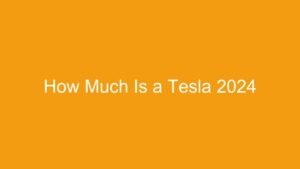
Contents
- How Much Will the Tesla Model S Cost? Your Ultimate Guide to Understanding the Price Tag
- 🛒 Recommended Product
- Understanding the Starting Point: The Tesla Model S MSRP
- Step-by-Step: Building Your Model S and Calculating Its Cost
- 🛒 Recommended Product
- Beyond the Sticker Price: Hidden Costs & Long-Term Savings
- Tips for Smart Shopping & Budgeting Your Model S
- Common Mistakes to Avoid When Estimating Model S Cost
- Conclusion: Your Tesla Model S Awaits!
- 🛒 Recommended Product
- FAQ
How Much Will the Tesla Model S Cost? Your Ultimate Guide to Understanding the Price Tag
Dreaming of cruising in a Tesla Model S? You’re not alone! This iconic electric sedan, known for its exhilarating performance, long range, and cutting-edge technology, captures the imagination of drivers worldwide. But before you picture yourself behind the wheel, a big question often arises: “How much will the Tesla Model S really cost me?”
It’s a fantastic question, and one without a single, simple answer. The price of a Model S can vary significantly based on your choices, the current market, and what you prioritize. Think of it less like a fixed price tag and more like a customizable experience.
This detailed guide will walk you through all the factors that contribute to the final cost of a Tesla Model S, from the initial purchase price to long-term ownership expenses and potential savings. We’ll provide step-by-step insights, valuable tips, and common mistakes to avoid, all to help you budget confidently for your electric dream machine.
🛒 Recommended Product
Understanding the Starting Point: The Tesla Model S MSRP
Let’s begin with the manufacturer’s suggested retail price (MSRP). This is your baseline, the cost before any customizations or additional fees.
Currently, the Tesla Model S is offered in two main variants, each with its own starting MSRP:
- Tesla Model S (Long Range): This is the foundational model, offering an impressive blend of range, performance, and luxury. Its starting price typically hovers around $74,990 (as of late 2023/early 2024, but remember, Tesla prices can change frequently – always check the official Tesla website for the most up-to-date figures!).
- Tesla Model S Plaid: For those who crave ultimate performance, the Plaid variant pushes the boundaries with mind-bending acceleration and power. Its starting price is significantly higher, generally beginning around $89,990.
Remember: These are just the starting prices. Consider them your blank canvas!
Step-by-Step: Building Your Model S and Calculating Its Cost
Ready to customize your Model S and see how the price evolves? Here’s a breakdown of the key decisions that will impact your final purchase price:
Step 1: Choose Your Model/Variant
This is your first and most significant cost decision.
* Decision: Do you want the Model S Long Range for its excellent balance, or the Model S Plaid for its unparalleled performance?
* Cost Impact: This choice sets your initial price by approximately $15,000 to $20,000. The Plaid offers more power and features but comes at a premium.
Step 2: Select Your Exterior Color
While often overlooked, paint can add a few thousand dollars to your total.
* Decision: What color catches your eye?
* Cost Impact: Pearl White Multi-Coat is typically the standard, no-cost option. Other colors like Solid Black, Midnight Silver Metallic, Deep Blue Metallic, and Ultra Red (often a premium color) can add anywhere from $1,500 to $3,000 or more to the price.
🛒 Recommended Product
Step 3: Pick Your Wheels
Wheels aren’t just for aesthetics; they can also subtly influence range and handling.
* Decision: Standard or upgraded wheels?
* Cost Impact: The 19″ Tempest Wheels are usually standard. Upgrading to 21″ Arachnid Wheels can add approximately $4,500 and might slightly reduce the estimated range due to increased rolling resistance.
Step 4: Decide on Interior Configuration
Your interior is where you’ll spend most of your time, so choose wisely!
* Decision: Which interior color and trim appeal most to you?
* Cost Impact: Black Interior is often standard. Upgrading to a Cream or White Interior can add about $2,000 to the total. These options usually include a wood or carbon fiber trim accent, depending on the variant.
Step 5: Consider Autopilot and Full Self-Driving (FSD) Capability
This is one of the most significant optional upgrades and a major cost factor.
* Decision: How much autonomy do you want?
* Cost Impact:
* Basic Autopilot comes standard and includes features like Traffic-Aware Cruise Control and Autosteer.
* Enhanced Autopilot (sometimes available as an option or included in some configurations) adds Navigate on Autopilot, Auto Lane Change, Autopark, and Summon for an additional cost (e.g., around $6,000).
* Full Self-Driving (FSD) Capability is Tesla’s most advanced driver-assistance package, including all Enhanced Autopilot features plus Traffic Light and Stop Sign Control and Autosteer on city streets (currently in beta). This is a substantial investment, often priced at $12,000 (one-time purchase) or available as a monthly subscription (e.g., $199/month). Be aware: FSD does not make the car fully autonomous; the driver must remain attentive and ready to take control.
Step 6: Explore Other Upgrades & Accessories
Beyond the main configurator, there are often smaller, but still impactful, additions.
* Decision: Do you want a Carbon Fiber Spoiler (for Plaid), or home charging equipment?
* Cost Impact:
* A Carbon Fiber Spoiler for the Plaid can add around $1,000.
* Home Charging Equipment, such as a Wall Connector, is highly recommended for convenience and can cost $400-$600 plus installation (see “Hidden Costs” below).
* Premium Connectivity (free for a trial period, then a monthly subscription) for live traffic visualization, satellite-view maps, video streaming, etc.
Beyond the Sticker Price: Hidden Costs & Long-Term Savings
The price you build in the configurator isn’t the final amount you’ll pay initially, nor does it reflect the full cost of ownership. Let’s look at the bigger picture:
Initial Additional Costs:
- Destination/Delivery Fee: Tesla charges a mandatory fee for transporting the car to your delivery center, typically around $1,390.
- Order Fee: A non-refundable fee of around $250 is usually required when placing your order.
- Sales Tax: This varies significantly by state and municipality. It’s calculated on the total purchase price and can add thousands of dollars. Don’t forget this!
- Registration & Licensing Fees: Your state’s Department of Motor Vehicles (DMV) will charge annual fees for registration and license plates.
- Documentation Fees: Dealerships (including Tesla, as a direct seller) often charge small administrative fees.
- Home Charging Installation: While the Wall Connector hardware is one cost, hiring an electrician to install it (and potentially upgrade your electrical panel) can range from $500 to $2,000+, depending on your home’s setup. This is a crucial upfront investment for convenient charging.
Ongoing Ownership Costs:
- Insurance: EVs, especially high-performance luxury models like the Model S, can have higher insurance premiums. Factors like your driving record, location, and the car’s value heavily influence this. Always get an insurance quote before buying.
- Charging Costs: This replaces your gasoline budget!
- Home Charging: Charging at home using off-peak electricity rates is generally the cheapest way to “fuel” your Tesla, often equating to significantly less per mile than gasoline.
- Tesla Supercharging: Convenient for long trips, but more expensive per kWh than home charging. Still, it’s typically competitive with gas prices for comparable range.
- Maintenance: EVs generally require less maintenance than gasoline cars. No oil changes, spark plugs, or complex exhaust systems. You’ll still need to consider tire rotations, brake fluid checks, cabin air filter replacements, and eventual tire replacements.
- Tire Replacement: High-performance EVs like the Model S can wear through tires faster than conventional cars, especially if driven enthusiastically. Replacement tires can be expensive.
Potential Savings & Incentives:
- Federal Tax Credits: The Model S has historically not qualified for the current federal EV tax credit due to its price point and battery sourcing requirements. Always verify current eligibility on the IRS website or Energy.gov. Eligibility rules frequently change.
- State & Local Incentives: Many states, counties, and cities offer their own incentives, which can include:
- Tax credits or rebates
- Reduced vehicle registration fees
- HOV lane access
- Utility rebates for home charger installation
- Exemptions from emissions testing
- Look up incentives specific to your region!
- Fuel Savings: This is often the biggest long-term saving! You’ll no longer pay for gasoline. The money saved on fuel can significantly offset the car’s purchase price over time.
- Lower Maintenance Costs: As mentioned, fewer moving parts mean fewer scheduled maintenance items and lower overall service costs compared to internal combustion engine (ICE) vehicles.
Tips for Smart Shopping & Budgeting Your Model S
- Use the Official Tesla Design Studio: This is your best tool. Go to Tesla’s website, click “Order” for the Model S, and meticulously build your desired configuration. The configurator will give you a real-time price estimate that includes destination and order fees.
- Prioritize Your Options: Distinguish between “must-haves” and “nice-to-haves.” That premium color or larger wheel upgrade can quickly add thousands.
- Factor in ALL Costs: Don’t just look at the MSRP. Create a comprehensive budget that includes taxes, registration, insurance, and potential home charging installation.
- Consider Financing vs. Cash: Understand how financing options (APR, loan term) will impact your monthly payment and overall cost.
- Explore Used Models: A used Model S can offer significant savings while still providing an incredible driving experience. Older models might not have all the latest features, but they still retain much of their core appeal.
- Stay Updated on Incentives: Check government and local utility websites regularly, as incentives can change or expire.
- Get Insurance Quotes Early: Before you commit, get a few insurance quotes for the exact Model S configuration you’re considering. This can prevent sticker shock later.
- Test Drive: Experience the Model S for yourself. It helps you decide if the value justifies the cost for you.
Common Mistakes to Avoid When Estimating Model S Cost
- Ignoring the “Add-Ons”: Many people focus solely on the base price and forget how quickly options like paint, wheels, and especially Full Self-Driving Capability can inflate the total. These additions are significant!
- Forgetting Taxes and Fees: Sales tax alone can add thousands of dollars. Always calculate these before finalizing your budget.
- Not Researching Insurance: Assuming your EV insurance will be similar to your old car is a big mistake. Performance EVs often have higher premiums.
- Underestimating Home Charging Installation: The convenience of charging at home is invaluable, but the setup isn’t always free. Budget for professional installation.
- Assuming All Incentives Apply: Just because an EV tax credit exists doesn’t mean your specific Model S or your income level will qualify. Verify, verify, verify!
- Not Considering Long-Term Running Costs: While lower, charging and tire replacements are still expenses. Factor them in.
Conclusion: Your Tesla Model S Awaits!
The Tesla Model S is a remarkable vehicle that offers an unparalleled blend of performance, technology, and electric efficiency. Understanding its true cost, however, requires a bit of homework. By carefully considering the variant, your desired options, and all the associated fees and potential savings, you can confidently determine how much your dream Model S will cost.
🛒 Recommended Product
Remember: The most accurate way to get a price for your specific configuration is to use the official Tesla Design Studio online. Take your time, explore the options, and build the Model S that perfectly fits your lifestyle and your budget. Happy configuring!
FAQ
Q. What is the starting price for a new Tesla Model S?
A. The starting price for a new Tesla Model S (Long Range variant) typically hovers in the range of $72,990 to $74,990, before any options, destination fees, or potential incentives. However, Tesla frequently adjusts its pricing, so it’s always recommended to check their official website for the most current figures.
Q. How does the ‘Long Range’ trim compare in price to the ‘Plaid’ trim?
A. The ‘Plaid’ trim, being the high-performance variant, carries a significantly higher price tag than the ‘Long Range’ model. While the Long Range might start in the low-$70,000s, the Plaid model typically begins around $87,990 to $89,990, reflecting its superior acceleration and power. These prices are subject to change.
Q. What are some common optional features and their approximate costs that can increase the Model S price?
A. Popular optional features can add substantially to the total cost. The “Full Self-Driving Capability” package is a significant one, often priced at $12,000 to $15,000 if purchased upfront. Other additions include premium paint colors (e.g., Ultra Red, Stealth Grey) which can be $1,500 to $2,500, and larger or different wheel options (typically $2,000 to $4,500).
Q. Are there any federal tax credits or state incentives available for purchasing a new Tesla Model S?
A. Eligibility for federal tax credits for the Tesla Model S has varied significantly over time, often depending on factors like the vehicle’s manufacturing location, battery component sourcing, and the buyer’s income. As of recent updates, the Model S may not qualify for the full federal EV tax credit due to various criteria, including price caps. However, state or local incentives (like rebates, tax credits, or HOV lane access) can sometimes apply, so it’s crucial to check specific programs in your region or consult a tax professional.
Q. What other fees, like destination or documentation fees, should I expect when buying a Model S?
A. When purchasing a new Model S, you should anticipate a mandatory destination and documentation fee, which covers the cost of transport from the factory to the delivery center and administrative processing. This fee is typically around $1,390 to $1,640 and is added to the vehicle’s price before taxes. Local registration, title, and sales tax will also apply based on your state’s regulations.
Q. How much can I expect to pay for a used Tesla Model S?
A. The cost of a used Tesla Model S can vary widely based on its year, mileage, condition, trim level (Long Range vs. Plaid), and included features (like FSD). Older models (e.g., 2012-2016) can be found in the $20,000 to $40,000 range, while newer used models (2018-2022) with lower mileage might range from $40,000 to $70,000 or more, especially for Plaid versions. Market demand also plays a significant role in used car pricing.
Q. Has the price of the Tesla Model S changed significantly over time?
A. Yes, Tesla is known for frequently adjusting its vehicle pricing, and the Model S is no exception. Over the years, its price has fluctuated due to changes in production costs, battery technology, market demand, and strategic pricing decisions. It has seen both increases and decreases in its base price, sometimes within the same year, making it important to check current pricing when considering a purchase.
Related Articles
How Much Does a Tesla Cybertruck Cost
How Much Does a Tesla Cybertruck Cost? Your Ultimate Guide to Pricing & Purchase The Tesla Cybertruck has captured imaginations with its futuristi…
How Much Is a Tesla
How Much Is a Tesla? Unpacking the Cost of Your Dream EV Dreaming of driving a Tesla? You’re not alone! These innovative electric vehicles have …
Affiliate Disclosure: As an Amazon Associate, I earn from qualifying purchases made through links on this site.















